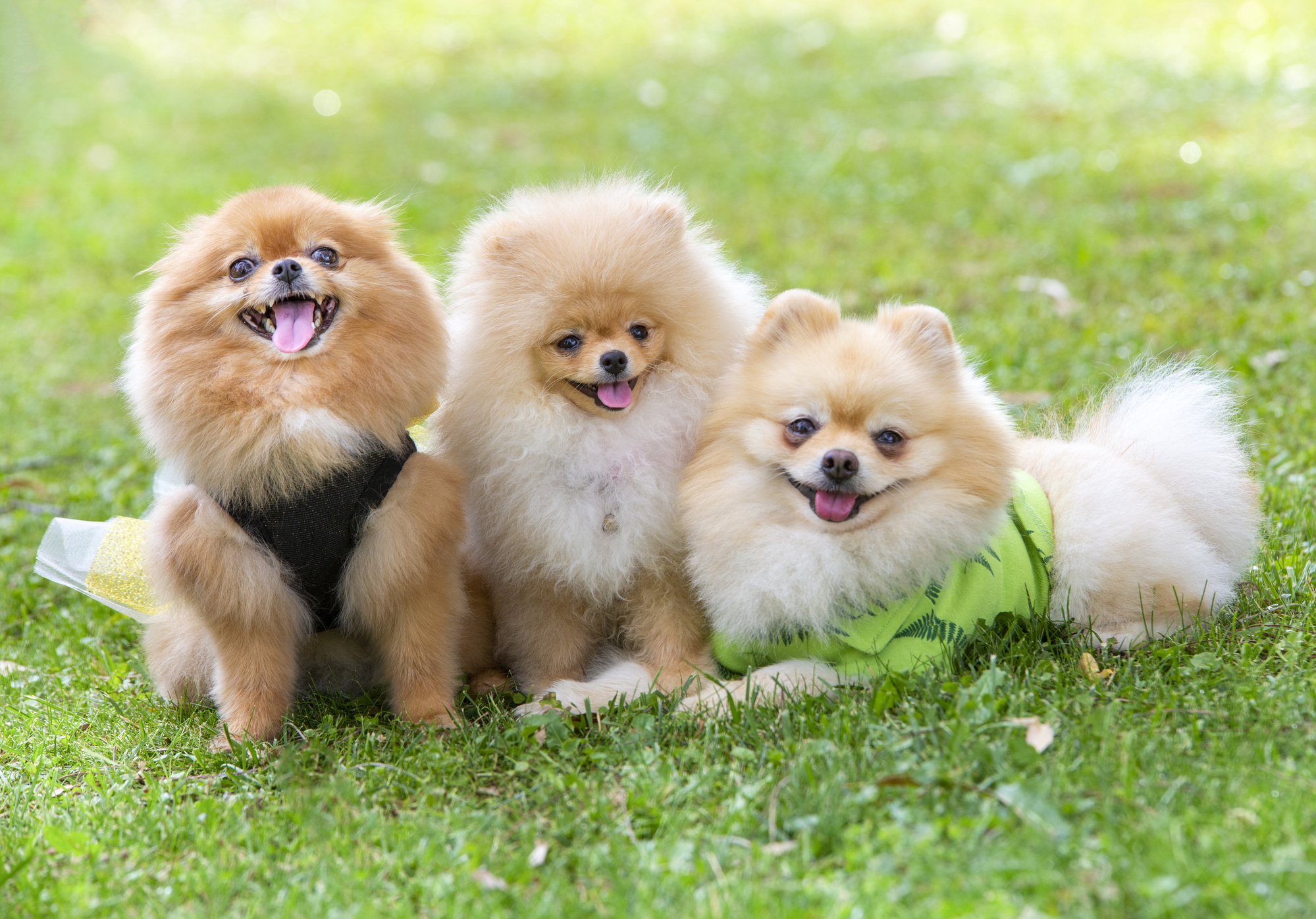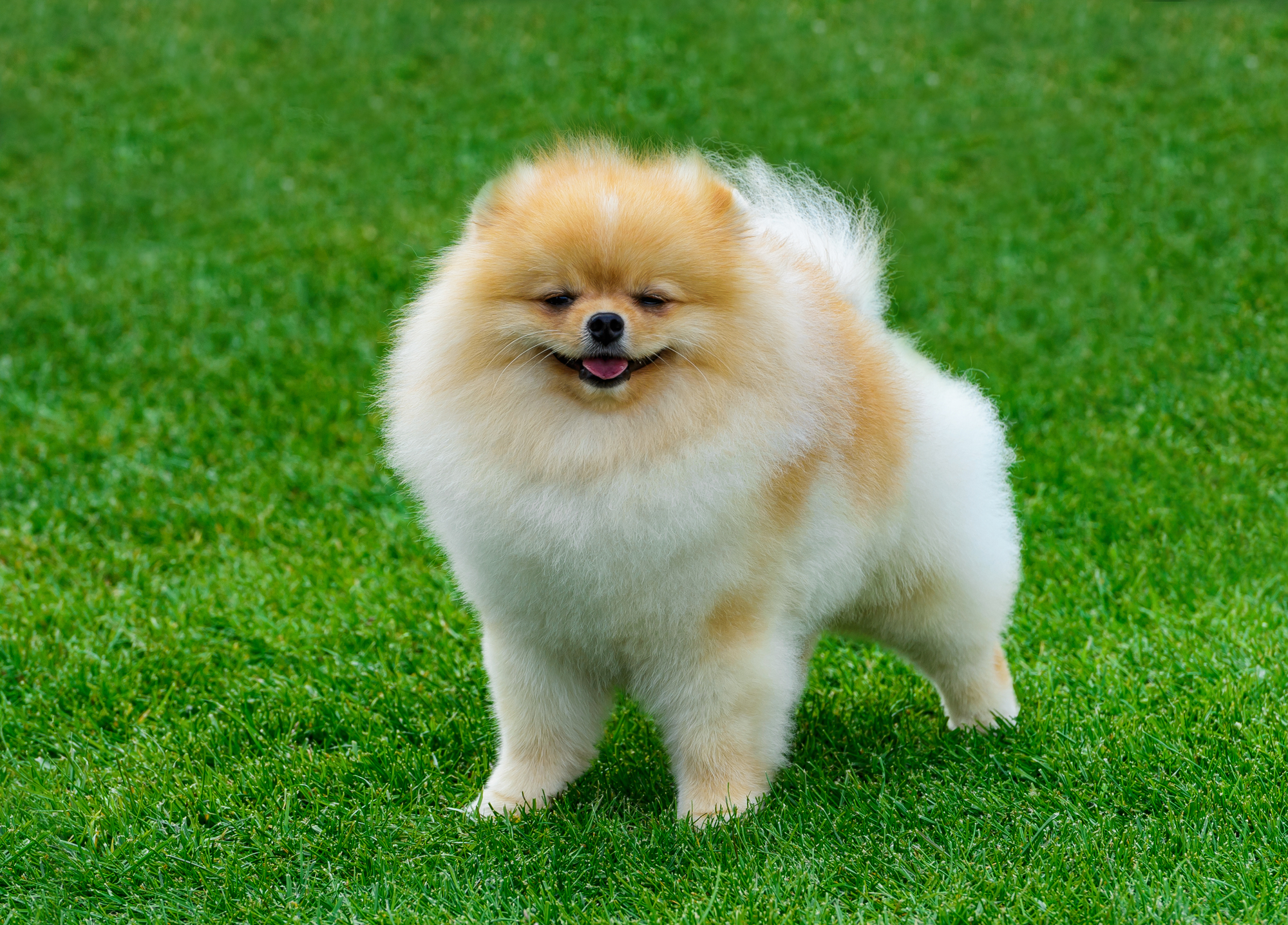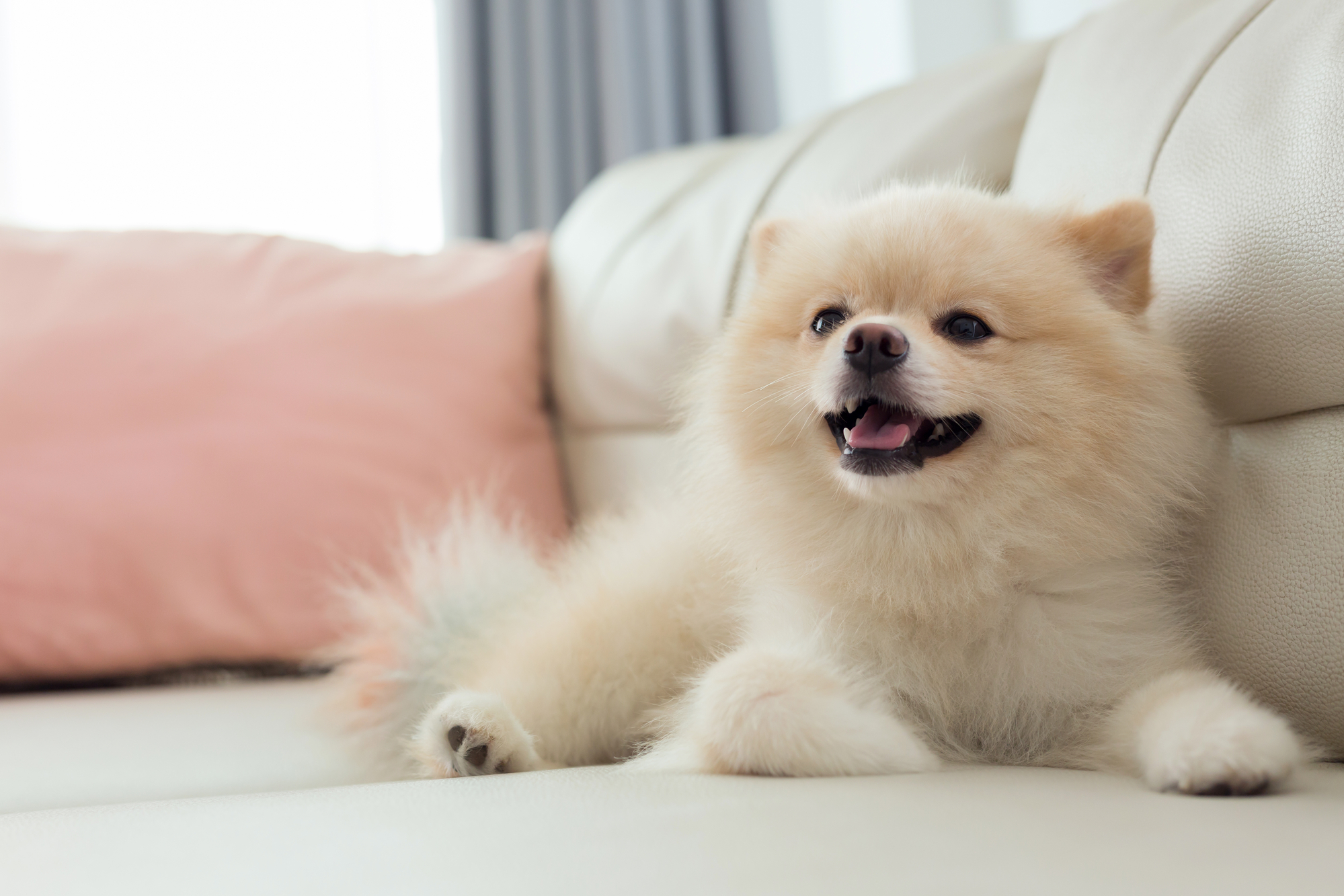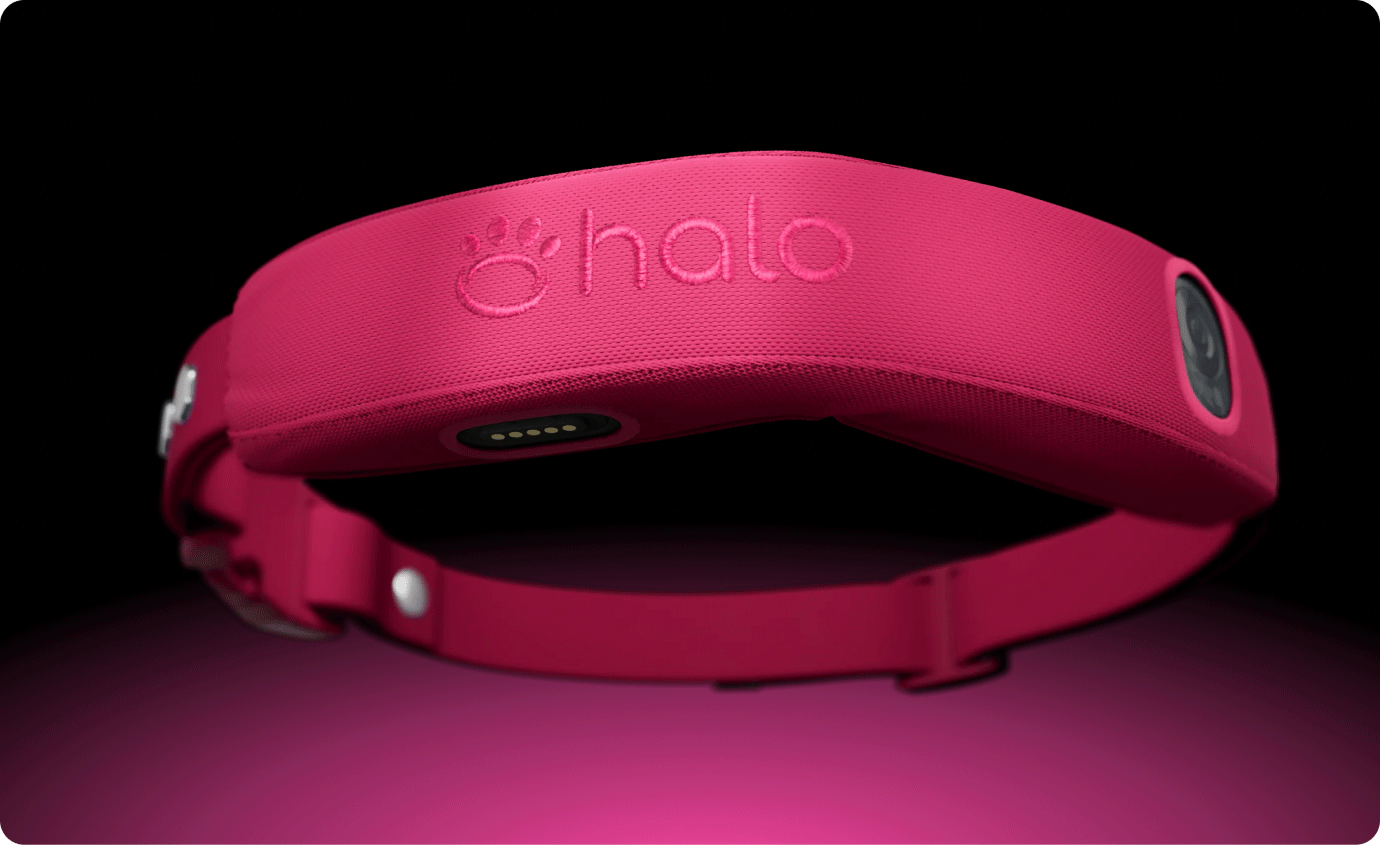Your Cart

Halo is backed by a 90-day satisfaction guarantee
Subtotal$0
Tax & Shipping Calculated at checkout
Total $0
Descendants of larger Spitz-type dogs, Pomeranians cram their ancestors’ bold and independent spirit into tiny packages. These fluffy companions, affectionately known as poms, have a long history of charming humans. Feisty and self-assured, this popular dog breed commands respect and requires proper care.
In this guide, we’ll explore Pomeranians’ appearance, training needs, grooming routines and unique quirks.
These fluffy companions, affectionately known as poms, have a long history of charming humans.

Male: Weight: 3-7 lbs; Height: 6-7 inches
Female: Weight: 3-7 lbs; Height: 6-7 inches
Yes, with proper socialization
Yes, with careful introductions and supervision
Excellent with proper training and socialization
Easy to train but prone to stubbornness
Bathing every 3 months, brushing every day and nail clipping every few weeks
12-16 years
Lively, loyal, confident
Playful, energetic, intelligent
All colors, including solid, parti and bicolor
Adjustable; Fits most dogs

Pomeranians might be small, but they make up for it with a big presence. Here’s what to expect from their classic appearance:
Males and females are similar in size. Sometimes, males are larger with slightly thicker coats. Just remember, these differences are subtle and individual variation plays a significant role in a Pomeranian’s overall appearance.
Pomeranians are intelligent dogs with a strong desire to please. This makes them enjoyable training partners for the most part. That said, they have an independent streak that sometimes translates into stubbornness. Here’s how to harness your dog’s full potential and build a strong foundation for a well-behaved companion.
Here are tips for training your Pomeranian puppy:
Advanced skills Poms excel at include:
Pomeranians have a set of quirks and needs that might affect how you train them. These include:
Training is a lifelong process. Your commitment to continued practice and reinforcement will shape your Pomeranian into a well-mannered, happy and confident companion.
The Pomeranian’s double coat is a source of beauty and responsibility. A dedicated grooming routine is essential to keeping its fur healthy and tangle-free. Daily brushing is the cornerstone of this routine. Invest in a high-quality slicker brush and a metal comb. Brush with the direction of hair growth to prevent painful matting and ensure you reach the undercoat. In general, aim for at least three to four thorough brushing sessions per week.
Regular baths keep your Pomeranian clean and smelling fresh. For optimal results, bathe your dog every 3 months or so. Use a gentle, high-quality shampoo and conditioner formulated for double-coated breeds. After rinsing, towel-dry your dog and follow up with a blow-dryer on a cool or warm setting. Blow-drying double-coated dogs is one of the best ways to prevent matting and keep their coat soft and shiny.
Another aspect of Pomeranian care is nail trimming. Overgrown nails are uncomfortable and can affect your dog’s gait. Trim its nails every few weeks using dog-specific clippers or a rotary machine tool.
In spring and fall, Pomeranians experience a period of heavy shedding called “blowing coat.” During these times, you might need to brush more frequently and consider a professional groomer’s help to manage the loose fur. If mats develop, resist the urge to cut them out yourself. Use a detangling spray and work the mats out with a comb. For severe matting, consult a professional to avoid damaging the coat. Shaving a double coat, even once, can prevent it from ever growing back.
Pomeranians are generally healthy dogs. But, like all breeds, there are some health conditions they’re more prone to. Here are common issues:
Some health problems in Pomeranians can have a genetic component. Responsible breeders screen their dogs to minimize the risk of passing down inheritable conditions. Consider asking your breeder about health screenings, or look for dogs with parents certified by organizations such as the Orthopedic Foundation for Animals (OFA).
Let’s look at the things you can do day-to-day to support a long and happy life for your Pomeranian:
Regular vet visits are nonnegotiable. Your veterinarian establishes a baseline for your Pomeranian’s health and provides essential preventative care. Don’t hesitate to contact your vet if your dog’s behavior, appetite or overall health changes.

Fueling a Pomeranian’s adventures — and maintaining its health — begins with the right food. Choose a high-quality dog food designed for small breeds. These special formulas pack the perfect balance of protein, fats and nutrients to keep your little companion thriving. Your veterinarian can help you select the best food for your dog’s individual needs.
Puppies have tiny tummies but big energy demands. Frequent meals are a must, so plan on feeding your growing Pomeranian three to four small portions throughout the day. As your puppy approaches its first birthday, you can transition to twice-daily feedings.
Like most dogs, Pomeranians love food and are prone to putting on a few extra pounds, so it’s important to keep an eye on your dog’s waistline. This is vital for maintaining joint health, heart health and overall well-being. Follow the recommended portions of your chosen food, but be prepared to adjust based on your dog’s activity level and condition.
Staying on top of your Pomeranian’s weight keeps it healthy and happy. Do this by giving it regular rib checks. You should be able to feel its ribs easily with gentle pressure and see a slight waistline. If you’re ever unsure about your Pom’s weight, your veterinarian is there to help with personalized guidance. And don’t forget that treats are special, so offer them in moderation!
Pomeranians have a surprising amount of energy. Meeting your dog’s physical and mental requirements results in a content, well-behaved companion. Let’s explore some tips:
Here’s how to make Pomeranian exercise part of your daily routine:
Pomeranians are prone to overheating, so be mindful of exercise during hot weather. Choose early morning or evening walks, provide plenty of water and watch carefully for signs of exhaustion.

Pomeranians are adaptable companions, but they come with specific needs and considerations. They thrive on attention, so prepare for your Pom to demand a starring role in your life. They’re vocal dogs, expressing themselves with enthusiastic barks and yips. If you live in an apartment or noise-sensitive environment, this is something to be aware of.
The Pomeranian’s delicate size means supervision is a must around young children. Early socialization with other pets is necessary, and you should monitor introductions to larger dogs closely. Poms have big personalities and strong instincts that can clash with less playful animals.
Environmentally, a Pomeranian’s tiny size makes it well-suited to apartment life — as long as you meet its exercise and mental stimulation needs. Poms are prone to heat and cold sensitivity, so climate control requires extra consideration.
Overall, sharing your home with a Pomeranian is akin to adding a ray of sunshine, a dash of sass and a lot of love to your life.
Here’s what to expect when you live with a Pomeranian:
If you’re ready for a furry shadow with a sprinkle of stubbornness, a Pomeranian will light up your world.
Pomeranians are wonderful companions for older children who understand how to interact gently with small dogs. Their playful nature and boundless energy can match a child’s enthusiasm. However, Poms are delicate. Adult supervision is vital at all times, even with well-intentioned children.
Teach children how to approach and play with a Pomeranian respectfully, emphasizing petting gently and giving the dog space. Early socialization with children helps your Pom feel comfortable and confident in their company. Just be sure to consider the individual personality of any dog, as some Pomeranians might have more patience with children than others.
Despite their diminutive size, Pomeranians need regular exercise to maintain physical and mental well-being. Daily walks are essential, with two sessions of 15-20 minutes being a strong starting point. These walks provide physical exercise and opportunities to sniff and explore the world.
Playtime, either indoors or in a secure, fenced-in yard, is another fantastic way to help your dog burn energy and have fun. Pomeranians love games such as fetch, chase and puzzle toys, which provide physical and mental stimulation.
Keeping a Pomeranian’s signature coat looking its best requires a committed grooming schedule. Daily brushing prevents mats and tangles, so give it at least three to four thorough brushing sessions per week. Invest in a good slicker brush and metal comb to effectively reach all layers of its coat.
Bathe your Pomeranian every 3 months using a high-quality dog shampoo and conditioner formulated for double-coated breeds. Don’t forget regular nail trims every few weeks to prevent painful overgrowth and changes in its gait.
Twice a year, Pomeranians “blow coat,” which might require more brushing and professional grooming help. Starting your dog’s grooming routine as a puppy helps it grow accustomed to being handled, making the process more enjoyable for everyone involved.
Pomeranians are easy to train with the right approach. Keep in mind that their independent streak can sometimes translate into a touch of stubbornness. Consistency and positive reinforcement are the secrets to success.
Short, frequent training sessions packed with praise and rewards keep your Pomeranian motivated and engaged. As with all dogs, starting training early helps establish healthy habits and strengthens your bond. Poms excel in obedience training and love learning fun tricks because of the extra mental challenge.
While Pomeranians are generally healthy, you should be aware of some health issues the breed is prone to. These include luxating patella, tracheal collapse, dental problems and eye issues.
Choosing a reputable breeder that prioritizes health screenings increases the chances of having a healthy puppy. Regular veterinary checkups and preventive care help you catch and manage potential health problems early.
With proper care and good health, Pomeranians have a long lifespan for a small breed. On average, they live 12-16 years. Some factors influencing lifespan include genetics, diet, exercise and access to quality veterinary care.
Pomeranians can coexist with other pets, provided you prioritize early socialization and careful introductions. Their feisty personality might lead to clashes with less playful or more dominant animals, so it’s important to supervise interactions, especially with larger dogs.
Introducing a Pomeranian to existing pets in a neutral space can help ease tensions and set the stage for a positive relationship. With patience and proper management, many Pomeranians learn to live happily in multi-pet households.
Pomeranians are adaptable companions, making them suitable for various living environments. They thrive in apartments due to their small size, provided you take them on plenty of walks and ensure they have lots of toys. A fenced-in yard is a perk, as Pomeranians enjoy the opportunity to run and play safely.
Poms are sensitive to heat and cold, so climate control within the home is important for comfort. Ultimately, a loving person who cares for their Pomeranian’s physical and emotional needs is the key ingredient for happiness.
Pomeranians are a solid choice for first-time dog owners who are prepared for the responsibilities of dog ownership. Their intelligence makes them trainable, and their affectionate nature creates a strong bond with their humans. That said, it’s important for potential owners to research the breed thoroughly to ensure it’s a good fit.
Choosing a high-quality diet formulated for small breeds keeps your Pomeranian strong and satiated. Both wet and dry food have advantages, and your vet can help you select the right option for your dog. While the occasional dog-safe treat is fine, be aware that human foods are often unhealthy or even harmful to dogs. Use beloved toys and enthusiastic praise as rewards for desirable behavior instead of treats wherever possible.

Pomeranians are wonderful companion dogs, and as a Pom’s best friend, you want to do everything you can to keep them healthy, active and safe. If you are looking for a versatile way to provide your dog with a safe perimeter, and a way to track how much exercise they get, investing in Halo Collar is a smart idea. Halo Collar is a wireless GPS fence with a convenient phone app that allows you to set up a safe perimeter at home, on walks, or nearly anywhere you take your dog. Shop for your Halo Collar today.

Halo is backed by a 90-day satisfaction guarantee
Subtotal$0
Tax & Shipping Calculated at checkout
Total $0